Discover the Dark Secrets of the Harmonic Minor Scale
How Yngwie Malmsteen’s “secret scale” can spawn a set of seven relative modes

I first became aware of the harmonic minor scale back in high school, originally as an abstract entity I learned in music theory class, in which the seventh note of the natural minor scale was raised a half step.
I later discovered that it was the “secret scale” that a certain young hot-shot, Strat-wielding shredder from Sweden named Yngwie Malmsteen was using to achieve his uber-dramatic “neoclassical metal” sound.
The harmonic minor scale can spawn a set of seven relative modes in the same way that the major scale does
Still, from a practical standpoint, I had no idea how to apply these two ostensibly related pieces of information to my own guitar playing.
I did, however, manage to cop a ham-fisted version of what a friend of mine called the “Spanish scale,” an exotic-sounding series of notes that worked well when played over two major chords a half-step apart from each other in a back-and-forth vamp.
I concluded that this scale, or at least some form of it, was probably what Iron Maiden were playing in their song “Powerslave.”
It wasn’t until well into my studies in college as a music major that the implicit logic of the harmonic minor scale and its raised seventh degree finally revealed itself. Lo and behold, I made the connection that the “Spanish scale” I had learned was actually just the harmonic minor scale’s fifth mode, meaning that scale starting from its fifth note, or degree, with that note heard as a new tonal center.
In this lesson, I’d like to present the theoretical basis of this relationship and reveal how the harmonic minor scale can spawn a set of seven relative modes in the same way that the major scale does.
All the latest guitar news, interviews, lessons, reviews, deals and more, direct to your inbox!
But before delving into the harmonic minor scale and its modes, and looking at practical applications of them, let’s first examine the scale of which it is a variant, natural minor.

Ex. 1 shows the E natural minor scale (E F# G A B C D), also known as the E Aeolian mode, which is made up of the same seven notes as the G major scale (G A B C D E F# ), but starting on its sixth degree, which makes it that scale’s sixth mode.
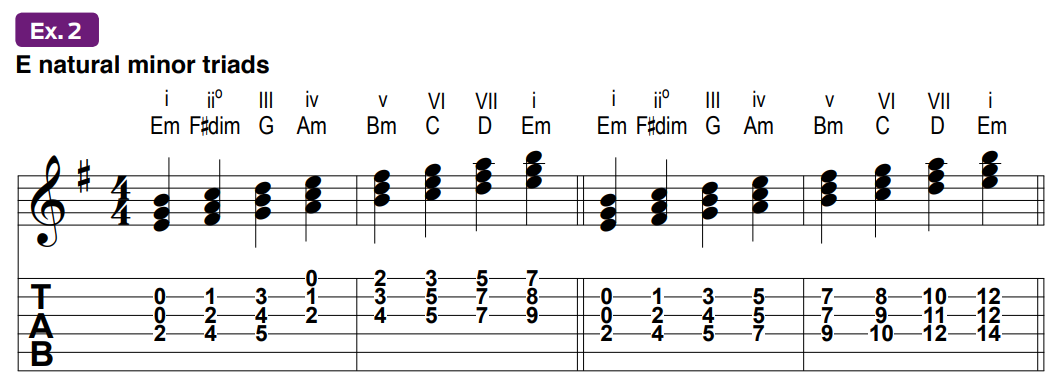
Ex. 2 illustrates the set of seven diatonic triads (three-note chords) that are generated from the E natural minor scale by harmonizing it in diatonic (scale-based) thirds and fifths on three adjacent strings.
These are the same seven triads that live within the G major scale, except here we’re starting on the note E and reckoning that as our new root, or tonal center.
Using these chords, we can jam out on the Aeolian progression Em-C-D-Em (theoretically spelled i-bVI-bVII-i) found in many classic metal and rock songs.
The one thing we can’t do, however, is have a traditional V-i resolution (B to Em in this case). Along with its major counterpart, V-I, this is the most essential chord change in music and an integral part of the harmonic language of most styles.
You’ll notice that the v chord (in formal music theory, a lowercase Roman numeral is used to indicate a minor-type chord) generated by the E natural minor scale is Bm, not B. Played before the i, Em, it gives us a rather weak-sounding harmonic resolution, as shown in Ex. 3.

This is because the Bm lacks a leading tone, which is a note a half step below the root of the chord or melody note to which you’re resolving.
In this case, the leading tone would be D#, which is the raised seventh scale degree that leads our ears compellingly back to the root of the Em chord.
Change the D note in the Bm chord to D#, and we now have a B chord (B D# F# ) which, when played before Em, creates a much stronger resolution.
Add to this B chord the dominant seventh tone, A, and we get a B7 chord (B D# F# A) and a much stronger and more satisfying resolution to Em, as demonstrated in Ex. 4.
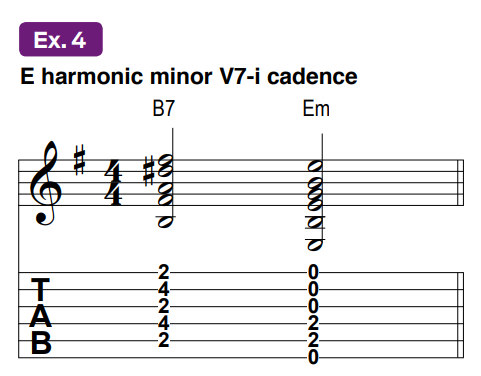
And so we’ve discovered the harmonic minor scale’s whole reason for being: Its raised seventh degree (D# in this case) serves as a harmonic and melodic leading tone a half step below the tonic E note in the key of E minor, guiding our ear back to Em and allowing us to have a more definitive-sounding V-i resolution – B to Em, or B7 to Em.
Ex. 5 depicts the notes of the E harmonic minor scale (E F# G A B C D# ), which are the same as those that comprise E natural minor, except the D note is now raised to D#.
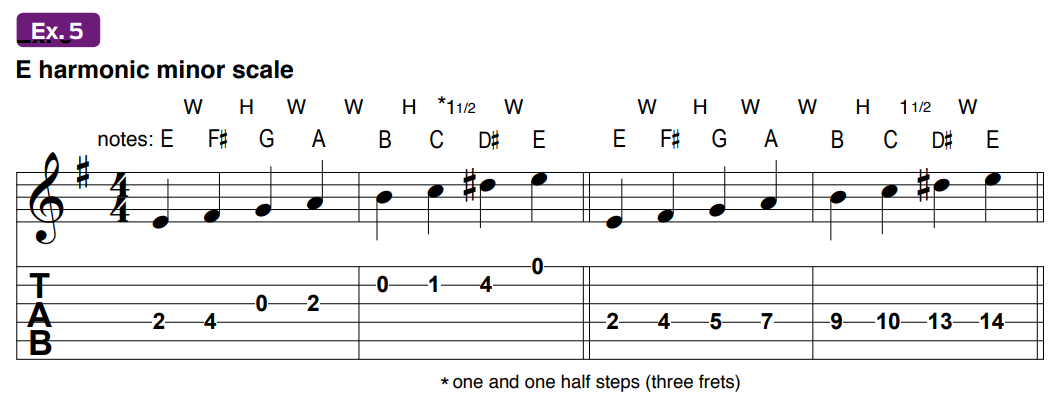
Notice how raising the seventh scale degree like this creates a wide gap of one and one half steps, or semitones, between the notes C and D#.
This wider interval is not found in the major scale and its modes, and it’s what gives the harmonic minor scale its distinctly exotic sound.

Let’s now spell out the diatonic triads of E harmonic minor (Ex. 6), followed by what are known as the scale’s diatonic seventh chords, which are the same as the triads but with another interval, the seventh, added on top of each root-third-fifth stack, again staying within the confines of the scale (Ex. 7).
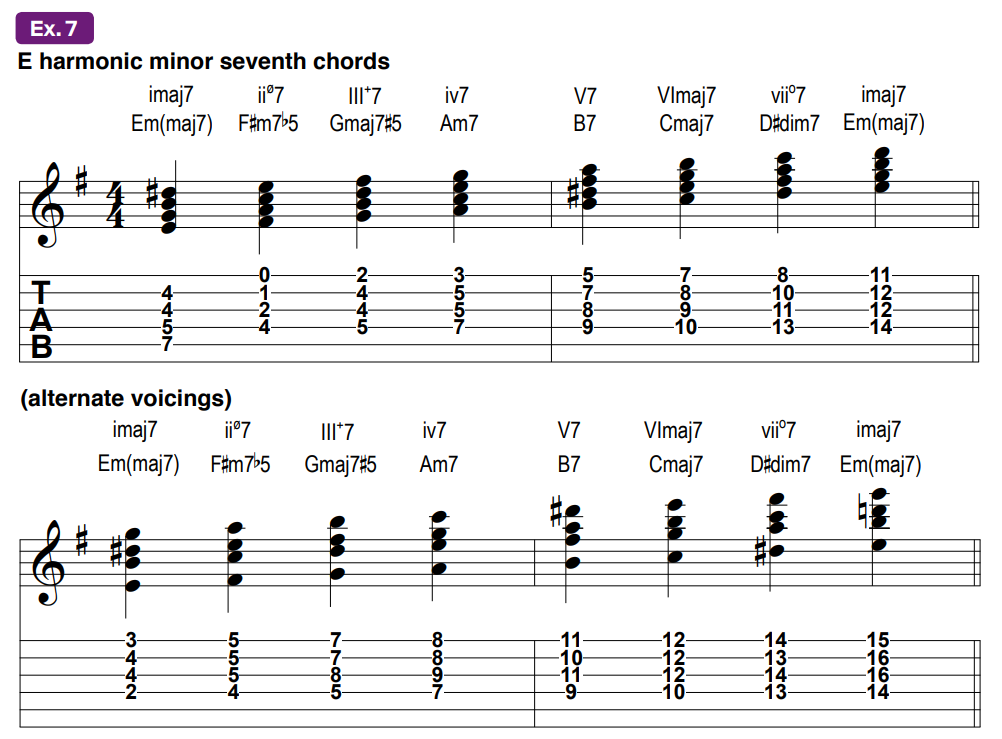
Notice that two sets of voicings are presented here, the second one requiring fewer wide fret-hand stretches.
Now let’s play through the E harmonic minor scale’s seven modes and their corresponding diatonic seventh chords, each based on a different, successive scale degree.
They are:
1. E harmonic minor (Ex. 8)

2. F# Locrian #6 (Ex. 9)
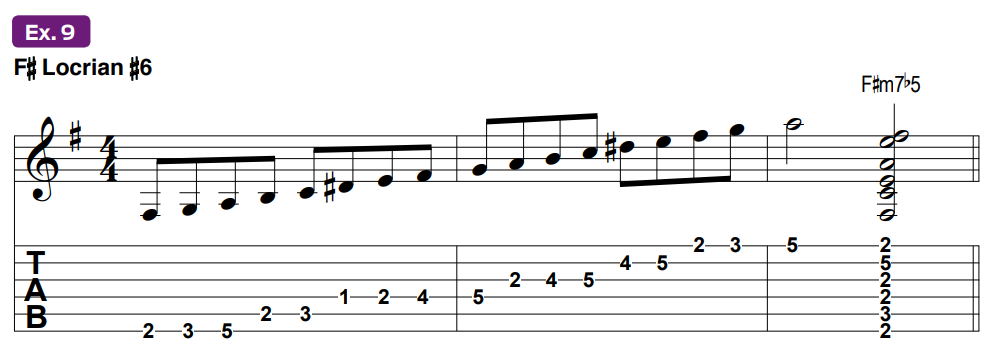
3. G Ionian-augmented (Ex. 10)
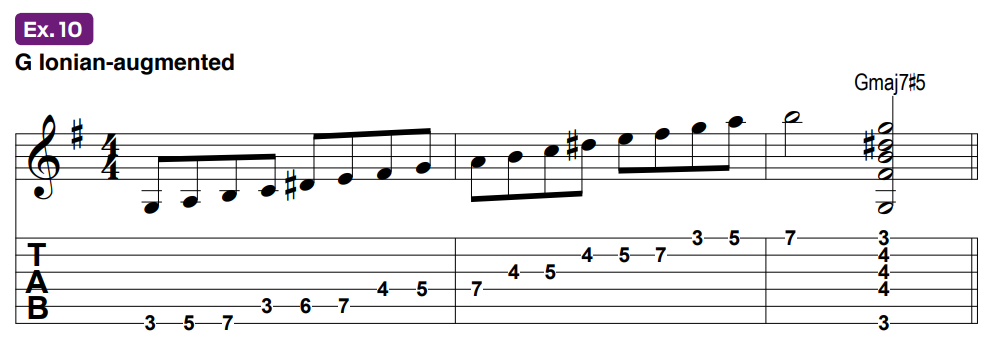
4. A Dorian #4 (Ex. 11)

5. B Phrygian-dominant (a.k.a. “Spanish Phrygian”) (Ex. 12)

6. C Lydian #2 (Ex. 13)
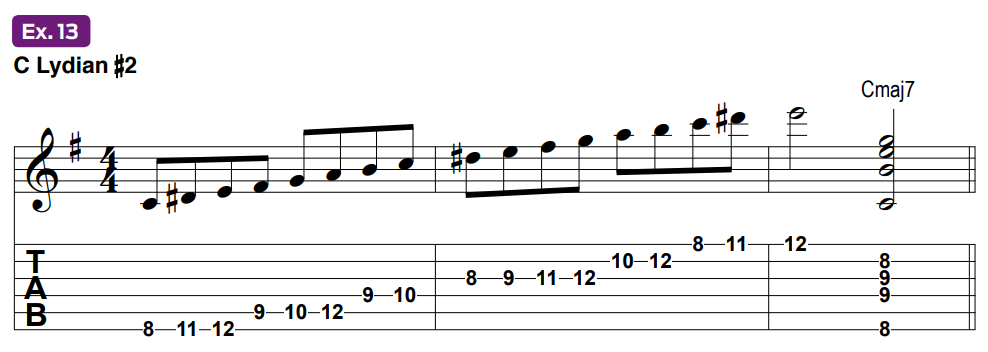
7. D# super-Locrian diminished (Ex. 14)
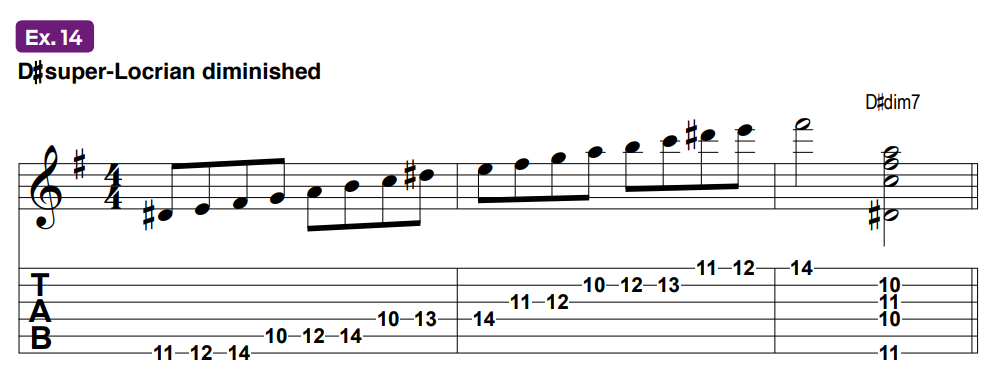
Despite their exotic-sounding names and tricky fingerings, these seven modes are nearly identical to those of the G major scale – G Ionian, A Dorian, B Phrygian, C Lydian, D Mixolydian, E Aeolian and F# Locrian – except that every D note has been raised to a D#.
The C-to-D# melodic skip forces us to contend with scale fingerings that are a bit more challenging than ordinary major and pentatonic scale shapes, with wide fret-hand stretches required.
In addition, they sometimes have first-finger slides to accommodate the playing of four notes per string, as well as three-fret jumps.
The tabbed fingerings I’ve provided here are just suggestions, so feel free to alter them to accommodate your style and personal preferences.
Also, if learning eight new scales seems daunting, just start with Ex. 15, which is the “closed” (completely fretted and thus movable) form of the root-position E harmonic minor from Ex. 8, and Ex. 12, the Phrygian-dominant mode, as these two scales/modes have by far the most practical applications in rock, jazz and world music.

THE ANDALUSIAN CADENCE
The Andalusian cadence is the name of a standard sequence of four descending chords in a minor key, specifically, i-bVI-bVII-V7. In the key of E minor, that would be Em-D-C-B7.
The first three chords are taken from the natural minor scale, and the last chord is the V7 with the raised seventh scale degree from harmonic minor.
The Andalusian cadence is the name of a standard sequence of four descending chords in a minor key, specifically, i-bVI-bVII-V7
If this all sounds a bit heady and obtuse, don’t fret. Chances are you’ve either played or heard it in a bunch of songs. It’s been around for hundreds of years and has been used in countless pop and rock songs over the past several decades, such as Del Shannon’s “Runaway,” the Stray Cats’ “Stray Cat Strut,” the Stone Roses’ “Made of Stone” and the Ventures’ “Walk, Don’t Run.”
When improvising over an Andalusian cadence, the first three chords may be approached with a natural minor or minor pentatonic scale, but adding the D# from the harmonic minor scale over the B7 chord in the last bar really helps spell out the V7-i resolution melodically.
Inspired by Slash’s soulful soloing in the Guns N’ Roses classic “Sweet Child O’ Mine,” Ex. 16 presents an eight-bar original solo line played over an Em-D-C-B7 Andalusian cadence.
It incorporates the E harmonic minor scale over the B7 chord in bars 4 and 8 and also draws upon E natural minor and E minor pentatonic (E, G, A, B, D) for the other six bars.

THE SPANISH PHRYGIAN MODE
Another common use of the harmonic minor scale involves tonicizing its fifth note.
In the case of the E harmonic minor scale, this simply means starting it from its fifth degree, B, and thinking of the corresponding B7 chord as our new, temporary key center.
Another common use of the harmonic minor scale involves tonicizing its fifth note
As explained earlier, this is officially known as the B Phrygian-dominant mode and sometimes called B Spanish Phrygian because of its extensive use in traditional flamenco music.
It can be heard in numerous rock, jazz and traditional folk tunes recorded over the decades, including Scorpions’ “Sails of Charon” (featuring Uli Jon Roth on lead guitar), Jefferson Airplane’s “White Rabbit” and John Coltrane’s “Olé.”
A common Phrygian-dominant chord vamp is to start on your major V or V7 chord (your temporary tonic) and go up a half step to a major or maj7 chord and/or down a whole step to the minor iv chord, for example, B7 to C (or Cmaj7) then B7 to Am.
Ex. 17 presents a melody played over this kind of progression, which is based entirely on the parent E harmonic minor scale.
For purposes of illustration, I’ve kept everything in seventh position for the first eight bars before traveling down the B string, using the open string as a pedal tone pitted against changing fretted notes.
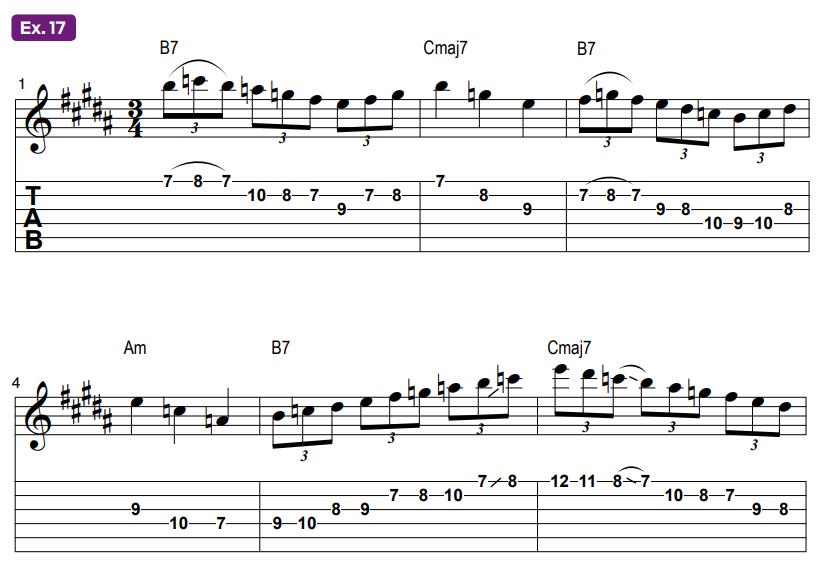
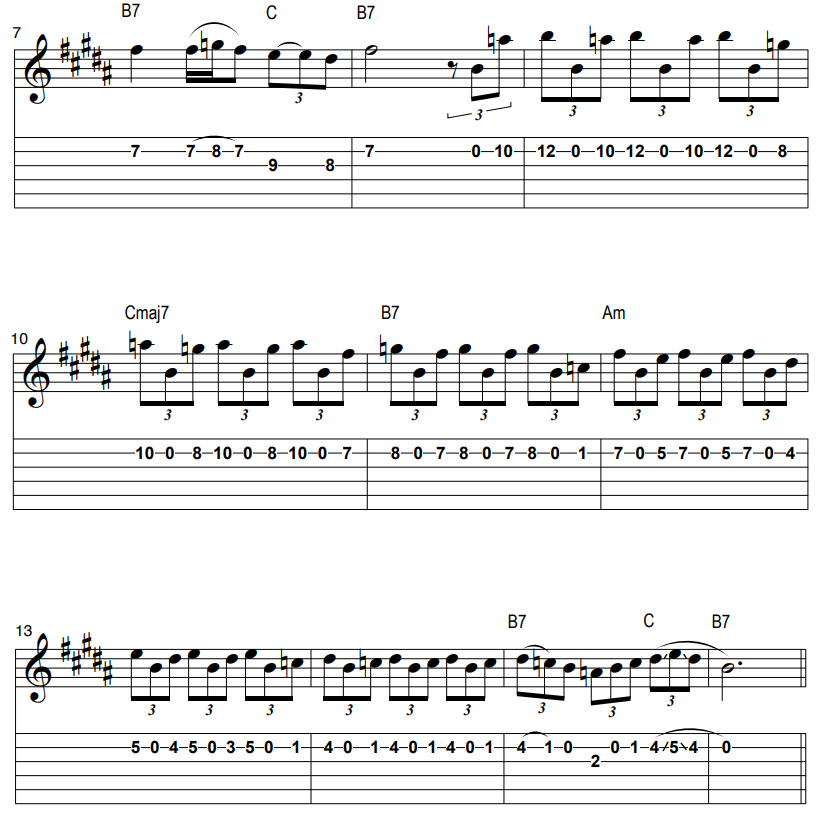
Keep in mind that the position doesn’t really matter, since a modal key center is determined by the chord progression, and so all eight of our modal fretboard shapes will work over the harmonic vamp.
To drive this point home, I’ve concluded the solo with a series of descending triplets on the B string that evokes Alex Lifeson’s Phrygian-dominant lead break in the instrumental Rush masterpiece “YYZ” and demonstrates how learning the seven modes of the harmonic minor scale all over the neck (in a handful of important guitar keys) can add a whole new dimension to your playing.
